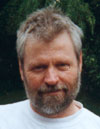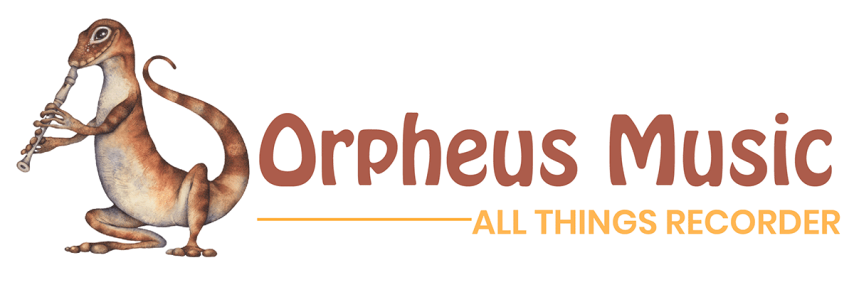No products
Prices are tax included
Orpheus Music - Ross Edwards Profile
By Benjamin Thorn - first published in Cinnamon Sticks Vol 3 No 1 May 2002

Ross Edwards has just completed his fourth symphony. He has also written popular concertos for violin, piano and percussion, yet for recorder players he is appreciated as the composer of several tiny and deceptively simple little pieces. These include his Ten Little Duets, published by Orpheus, another duet for trebles (in Recorders at Large vol 2) and Ulpirra for solo descant (Orpheus).
What is interesting is that both his large scale pieces and his miniatures show an individuality that is part of the essential Edwards.
Edwards was born in 1943 and grew up in Sydney wanting to be a composer eventually studying at Sydney (briefly) and Adelaide Universities and subsequently in Europe with Peter Maxwell Davies whom he had first met in Adelaide. He was one of a number of Australians who gravitated to York where Wilfred Mellors had established a new music course. Always regarded as one of the more talented composers of his generation he was exposed to and developed the techniques of the European avant-garde only to realise after his return to Australia in the early seventies that he didn't like them much. He "found that European music had lost its meaning - the gestures and syntax had become stale and irrelevant and even the tuning system it was based on seemed crudely inflexible." (1)
This generated something of a creative crisis as he sought inspiration from elsewhere eventually finding it in the nocturnal sounds of the Australian bush with static harmony, short phrases, and almost, but not quite regular repetitions and temporal structures. Edwards managed to derive two different styles from this material: a largely static style sometimes called his "sacred" style and a more lively dance style called his maninya style in which the insect patterns are ritualised. "Maninya" was originally a nonsense word used in a piece for voice and cello in 1981.
Since then he has been quite prolific and popular (though not always with some critics who think he has sold out to popularism) and has twice received an Australian Creative Fellowship from the Australia Council and in 1997 he was awarded the Order of Australia. His more recent music tends to bring a number of his stylistic influences (and even some time antipathies) together. His music has been used in films, notably in Bruce Beresford's Paradise Road, as well as appearing in the concert hall.
It was in the mid seventies that Edwards, along with several other composers, was asked to compose a short recorder piece in his case a duet, to be used in Steve Rosenberg's The Recorder Book II (subsequently called The Recorder Consort). Rain Dance (later called just Rain) was the result: a little modal piece for two descants that plays with the alternation and juxtaposition of 3/4 and 6/8. It seems an effortless little piece which is the basis of its charm but Edwards had worked hard within strict limitations: simple tonality, limited range, equally interesting parts for both players, to achieve this.
Edwards found the experience of writing in such a limited way quite liberating and over the next few years he composed another nine descant duets mainly as compositional relief when he was stuck for some reason while writing a larger work. The limitations on musical material continued throughout the series as did the rhythmic interest which makes some of them just a little trickier to play than they look. Very much dance pieces, they maintained regular metres until the tenth Celebration which plays with 5/8 and 4/8 and is very similar to the maninya pieces written at about the same time. The same is true of the Duet for two trebles which is a slightly trickier piece.
Because they are based on playing with rhythms and articulations the pieces work really well on recorders. They do not try to extend the recorder in any way and have in fact been picked up by teachers of a number of different instruments as good teaching pieces. This makes the fact that Edwards was unable to interest his publisher in them all the more puzzling. Perhaps they showed them to the wrong people. Several attempts were made but apart from the first one in the Rosenberg book and two more of them in Recorders at Large (and the Duet for two trebles in Recorders at Large vol 2) they were not published as a set until Orpheus Music brought them out a couple of years ago.
In 1993 Jo Dudley commissioned Edwards to write a solo piece and the result was Ulpirra. Very much in the maninya tradition it is a lively dance like piece in which the asymmetric rhythmic phrases are never quite the same and yet work organically to sound absolutely right. Again it is a piece that doesn't extend the recorder while still using its full range and requiring a fairly good technique but works very well on it. And like the little duets it has been adopted by a range of other instruments: Eb and bass clarinet, piccolo, soprano saxophone etc.
Edwards actually likes the idea of his pieces being played on different instruments. In a sense you could see this as reflecting his fairly diffident personality: not wishing to impose himself on the world in a single guise; but it is also practical in that it increases performance opportunities, after all in many cases the music is often not initially conceived in terms of a specific instrument, and interestingly different instruments also reveal different aspects of the music. Though it should be noted that some instruments work better than others.
It is not all a one way street either. Genevieve Lacey is thinking of performing Tyalgum Mantras which was written for shakuhachi, clap sticks and dijeridu. It will be interesting to see how well the recorder works as an appropriating instrument but I'm sure Ross looks forward to it in the same spirit.
The information in this article is derived from material on Ross Edwards' web site www.rossedwards.com and from various discussions with Ross and others.
(1) from a speech at ANU "Belonging Conference" November 1999.
